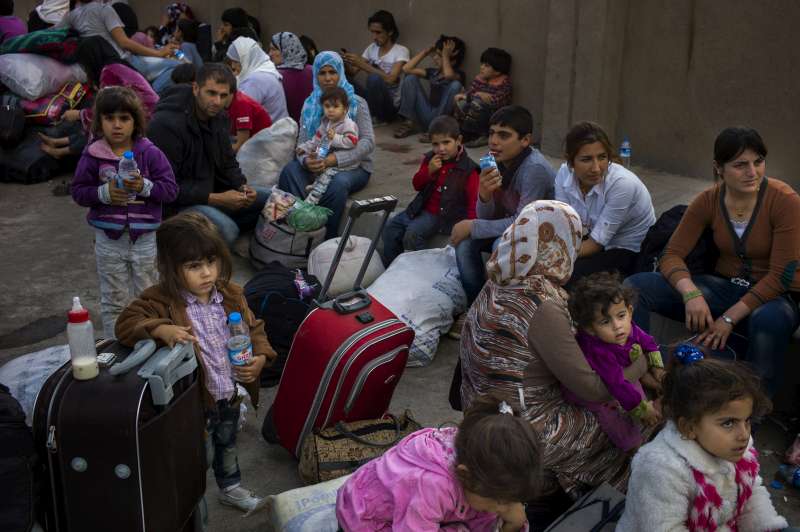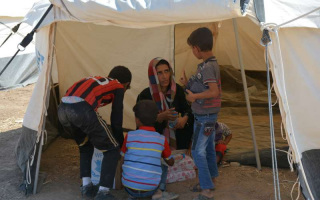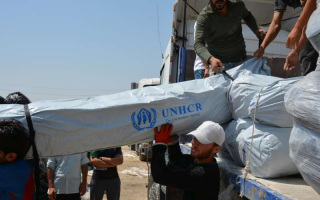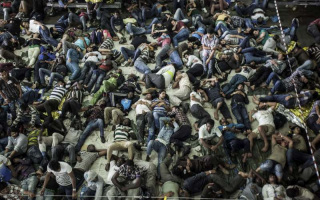
Syria and Iraq continue to be rocked by major population displacements. This image shows Syrian Kurds from the town of Kobane seeking shelter in Iraq’s Kurdistan region. © UNHCR D.Nahr
GENEVA, October 14 (UNHCR) –The UN refugee agency reported on Tuesday that an estimated 180,000 people have fled from the central Iraq town of Hit following its capture by ISIS and affiliated armed groups at the weekend.
The town’s mostly Sunni residents, as well as other Iraqis who had found refuge there in the past, fled to Ramadi, Khaldiya, Hadithat, Rawa, Ana, Amiryah Rahaliya and other places in Anbar province, as well as further afield in Kerbala and Baghdad, some 180 kilometres to the east. Many are sheltering with relatives and friends, as well as in schools, mosques and public shelters.
Hit had, until recently, been a safe haven for those who had fled earlier waves of violence in Ramadi, Fallujah and other parts of Anbar, providing shelter for some 100,000 displaced people.
“The exodus from Hit represents the fourth major wave of displacement in less than a year in Iraq, and for many of those caught up in it, it is the second, third or even fourth time that they have had to flee since January,” UNHCR’s chief spokesperson Melissa Fleming told journalists in Geneva. “Tens of thousands of desperate Iraqis are now caught in a rolling wave of multiple displacement amidst the conflict’s shifting frontlines,” she added.
UNHCR field staff met with some of the displaced while conducting a needs assessment in western Baghdad on Monday. Among them was a 30-year-old woman, originally from Ramadi, who had just fled from Hit with her elderly mother and disabled brother. The family has been displaced three times since January, fleeing the advance of ISIS throughout Anbar. They first fled to Khaldiya, where they stayed eight months, then to Hit for a month, before running for their lives once more in the past few days.
Another 27-year-old woman with two young children fled Hit after her husband was killed by shellfire. Though afraid to leave the house, she was even more afraid of ISIS rule if she stayed. After a 14-hour journey to Baghdad, she is now staying with relatives.
These families join Baghdad’s 75,000 internally displaced people whose key concerns include shelter, health care and finding a source of income. An estimated 1.8 million citizens have been internally displaced this year throughout the country.
UNHCR is sending mattresses, jerry cans, blankets and other relief items to the displaced in Ramadi, Kerbala, Abu Ghraib and the west of Baghdad. However, humanitarian access to large parts of Anbar province is extremely limited by the conflict.
Meanwhile in northern Iraq, an increasing number of Syrian Kurds from the besieged border town of Kobane are seeking shelter in Dohuk province having crossed the border from Turkey. Last Friday, the Iraqi Kurdish authorities opened the Ibrahim Khalil border, near Zakho, easing the journey for the steady stream of people who last week had to pay smugglers US$250 each to cross.
Some 5,400 Syrians from Kobane have now entered Iraq via Turkey, including 3,600 people in the last three days. Another 10,000 to 15,000 people are expected to cross in the coming days. The Syrians cite various reasons for moving on from Turkey. These include civil unrest; the high cost of living; difficulties with aid – especially with the looming winter; and family links to people living in the Kurdistan region of Iraq.
Upon arrival in Iraq, the asylum-seekers are screened by border authorities and transferred by the International Organization for Migration to Gawilan camp, set up a year ago for previous waves of Syrian refugees. But the camp reached its capacity this week and new arrivals from today onwards will be taken to the Arbat refugee camp in Suleymaniyah province, which can host an additional 7,000 people.
Talks are under way with the authorities to expand the Darashakran camp in Erbil province, if more people come. UNHCR is also setting up a reception centre at the Ibrahim Khalil border to protect the new arrivals from the elements while they are screened by border officials. UNHCR and its partners are at the border to identify particularly vulnerable people.
Iraq already hosts some 214,000 Syrian refugees with the vast majority residing in the Kurdistan region of Iraq. The more than 1.8 million internally displaced people in 2014 add to almost a million internally displaced people who had fled violence in previous years.





